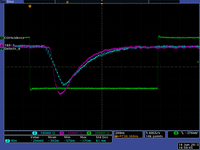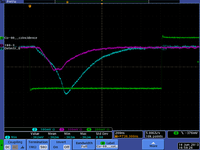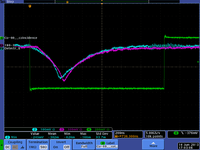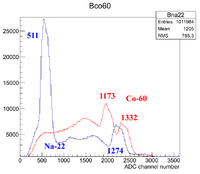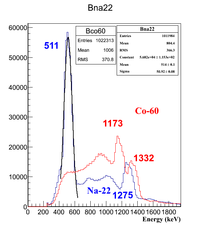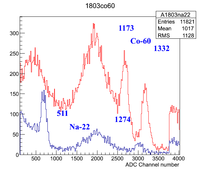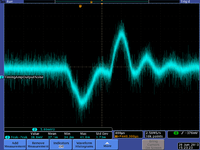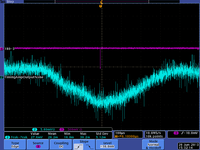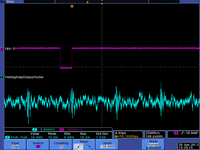Difference between revisions of "PAA CoincidenceCounting"
(→Au) |
|||
| Line 66: | Line 66: | ||
===Au-196 Meta state=== | ===Au-196 Meta state=== | ||
| + | The 8 sec metastable state of Au-196 decays through the emission of only one 84.66 keV photon. | ||
| + | |||
| + | The 9.6 hour metastable state has high intensity gamma lines at 147.81 keV and 188.27 keV. | ||
===Au-196 decay EC decay=== | ===Au-196 decay EC decay=== | ||
Revision as of 21:37, 12 July 2013
ADC non-linearity
Canberra Model 9615 < 0.04% (integral) over 2usec
Canberra Model 9633 < 0.025% (integral) < 0.9% (differential), +10V range into 1kOhm, 8192 channels, 100 usec signal width => 100 pC/chan
CAEN V792 < 0.1% (integral), 200 fC/chan
CAEN digitizer VX1492, 14 bit, 10 Volt range
Coinc Scope pictures
First pict with ADC gate
Two HpGe detectors were used to detect coincidence gammas from Co-60 on 6/14/2013.
Co-60 will beta decay to Ni-60 giving off two gammas in coincidence having energies of 1173 and 1332.5 keV. The scope pictures below record the pulses from the HpGe detector that are in coincidence. I would have expected the charge output by the HpGe detector to be similar for the two gammas, but there are some that have less than half the charge. The could be the beta particles from the decay reaching one of the detectors in coincidence with one of the gammas.
First Singles Spectrum
Detector B
Detector 180-3
50 keV Energy resolution from an HpGe detector??
I think the inverting amp is too noisy:
The Signal is about 400 mV and the above noise is 37 mV peak-to-peak and it is syncronized with my integrate gate
The voltage variations of the timing amp output in the region of the integrate gate are about +/- 10 mV
Proposed Apparatus
We propose to acquire two 14 bit digitizers (flash ADCs), a muli-hit time-to-digital converter, and the associated NIM electronics needed to supplement our current VME based data acquisition system. The availability of precision analog digitizers and pipeline time to digital converters allows the construction of a data acquisition system to record the pulse shape and time information that will allow the reconstruction of individual coincidence events. The most common method used to record photon spectroscopy information does so by accumulating events thereby loosing any temporal information. We propose a coincidence counting system which records the wave form of each coincidence event along with a time stamp. The system will allow a post data taking analysis that can increase the coincidence time constraint beyond the original requirement and ascertain the degree of confidence in identifying the decay under consideration.
Isotopes for CPAA
Au
Knock a neutron out of natural gold such that an excited state of Au-196 remains that will undergoe electron capture to Pt-196 with a half life of 6 days or it can be left in a meta stable state with two possible half lifes of 8 seconds or 9 hours.
Au-196 Meta state
The 8 sec metastable state of Au-196 decays through the emission of only one 84.66 keV photon.
The 9.6 hour metastable state has high intensity gamma lines at 147.81 keV and 188.27 keV.
Au-196 decay EC decay
in 6 days. The 355.73 keV transition line has 100% intensity.
The Pt-196 has a 355.73 dominant (100% relative intensity) gamma line that goes to the 256.2 state giving off a 97.3 keV photon
